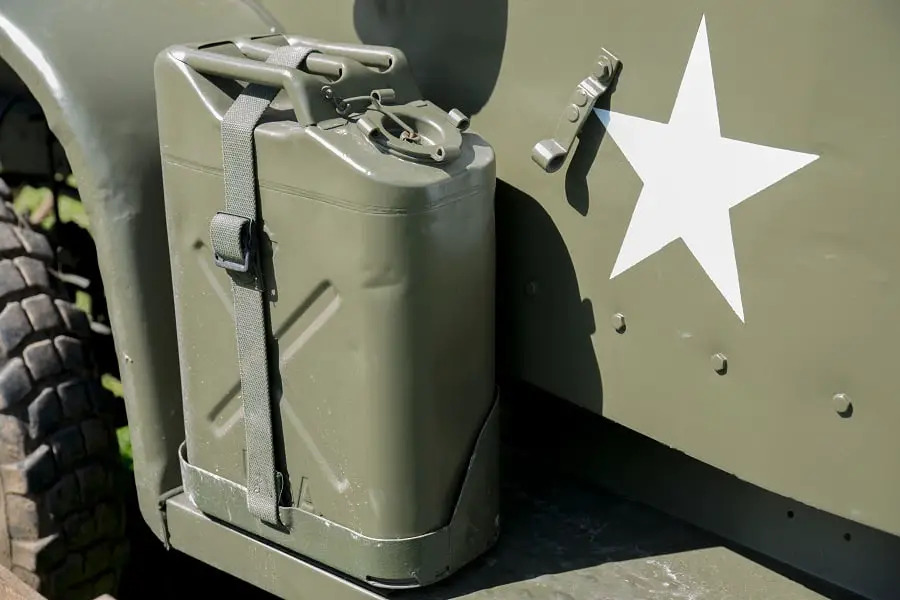
It is common for off-roaders to hit miles upon miles of unpaved roads while exploring the woods or the outback. That is technically an overlanding norm. Overlanding or off-roading, just as it sounds is, involves exploring uninhabited areas where there is technically no civilization. That may be in dense green forests, the woods, or even pristine beaches.
Running out of fuel in these regions, you will have a rough experience. There is no gas station in the woods or down the beach to fill up your off-road truck. That is why most off-roaders will have extra fuel storage for the overlanding experience.
What is the Best Way To Store Gas When on Overlanding Trip?
Selecting the appropriate gas cans for your overlanding itinerary is the initial step. The second and crucial step is safely transporting this gas until the point where you need to use it.
Follow these general guidelines when storing gas on your overlanding trip.
- Avoid carrying gas in passenger compartment
- Keep gas cans as far away from the vehicle cabin
- Always carry on the outside of the vehicle.
- Keep away from direct sunlight
- Attach to the back of the vehicle
- Put on the roof racks above the vehicle (careful in desert conditions)
First and foremost, storing this gas can inside the vehicle is tricky, especially if the gas is somehow a considerable amount. One thing you should always avoid is storing your gas can in the passenger compartment.
As mentioned earlier, fuel emits fumes, which could induce nausea and headache to the vehicle’s occupants. You will have a very uncomfortable trip rather than experience a memorable exploration in the desert or the woods. Storing gasoline in the passenger compartment may also lead to potential spills, and no one would want to stay in a vehicle with a pungent gas stench.
There are also several ignition sources in the car, like electric outlets, and these could easily spark the gasoline fumes blowing the vehicle up. That is why you are advised to keep the gas can as far as possible from the cabin.
Always carry the gas can outside the vehicle. That is the best way to store gas can when overlanding. It is almost impossible for the occupants to breathe the gasoline fumes with the can outside. However, it may seem tricky to store the can outside the vehicle, especially if you are exploring a hot weather area like a desert.
It would help if you also remembered that exposing the gas can to direct sunlight is never good. That means storing the gas can on top of the truck is not an option for the overlanders looking to explore the deserts. For these overlanders, the best way to safely store the gas cans is by attaching them to the back of the car. Some off-roaders consider covering the gas can with a material that keeps out the UV light and heat while in the desert.
As for the other off-roaders, you can install racks on your vehicle’s roof that will securely hold the gas can in place. It is a safe method of storing and transporting gas can as you hit the off-road. But again, remember it all depends on your itinerary.
How Does Carrying Gas Effect Driving?
Also, remember that gas is heavy and weighs around 6.3 lbs per gallon. Exerting too much weight on the vehicle’s roof will potentially affect its center of gravity. That may also dictate how the car will handle different terrain as you explore. Make sure you install a fire extinguisher nearby. You may have checked and done all precautionary steps, but an accident could happen. It is better to be ready in case of anything.
Keep Gas Cans in a Cool Place When Not Traveling
When your vehicle is not in use, remove these gas cans where you have attached them. It could be on top of the vehicle’s roof or behind the car near the rear wheel. Remove the gas cans and place them in a secluded and shady area. Do this even when you get home from the off-road trip, as it reduces fire and theft risks.
Types of Storage
The storage for fuel comes in two different forms, and this will largely depend on the type of overlanding vehicle you have. If your car can accommodate the long-range tank, then this is what you ought to purchase. The two forms of these storage cans include the long-range tank, and the jerry can type. Both have their distinctive benefits and drawbacks.
This long-range tank is constantly exposed to sunlight and can hold more capacity. Due to these fascinating features, the tank is quite expensive, and not every off-roader can install it. The jerry can is a viable way to store and transport gas. Militaries used it, and most people still use it even today. However, the jerry can cannot hold as much gas as you may wish, and you might be required to look for extra space to place it.
Long Range Tanks
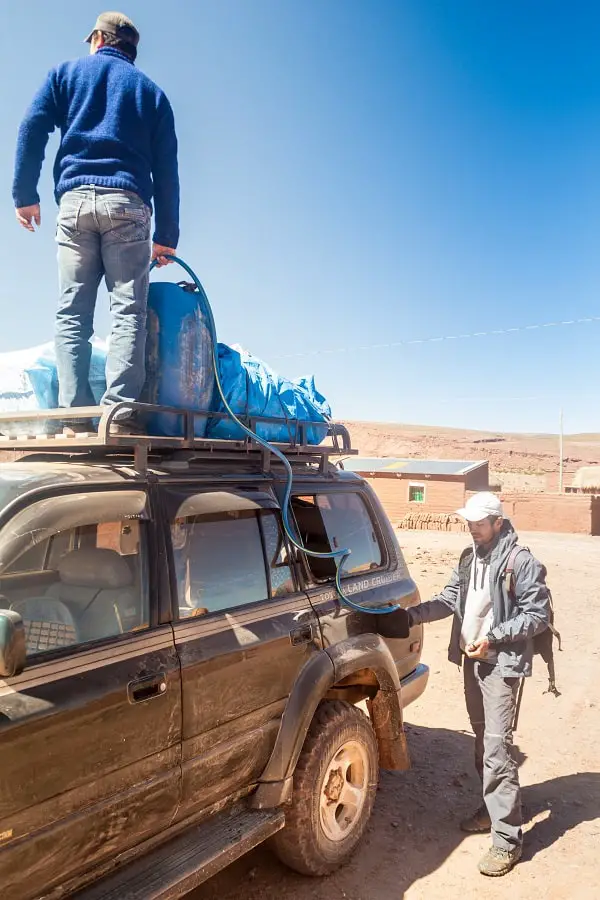
©mathess/123RF.COM
Many companies manufacture these long-range gas cans to cater to the needs of adventurous off-roaders. If your off-road truck has sufficient space to carry an extra fuel tank, then you should go for this option. Some are stored under the vehicle and can transfer gas to the main tank by pushing a button.
One of the significant benefits of this gas is that it holds more gas if your fuel is depleted while in the desert.
Jerry Cans
You can always resort to jerry cans for the off-roaders who do not want to use the long-range gas cans for one reason or the other. It is the second-best method of storing and transporting gas. With these cans, you do not have to worry about the suitability of the gas tanks. That is especially true if you are always looking for new trails to discover. It is a convenient off-road gas can.
Where Should You Store Gas Cans?
Gas cans can be used by off-roaders and homeowners alike. You need gasoline gas to run home maintenance machines such as power washers, leaf blowers, and lawnmowers as a homeowner. However, as you may be aware, gasoline is quite flammable and combustible. It bears explosive power.
That is why you need to store gasoline carefully. But how can you carefully store gas whether you are an off-roader or homeowner?
If you are not on the road and have a gas can for your Overlanding itineraries, here are several places where you can store that gas can at home.
Check Your Homeowner’s Insurance Policy and Local Laws on Gas Storage Regulations
Since gas is highly combustible and flammable, most cities will have laws and regulations that dictate how people store these cans. Homeowners are only allowed to store a reasonable amount of gas at home, especially for the home machines such as lawnmowers or hitting the road.
You do not need a permit to store these gas cans. Check with your fire department for an insurance policy.
Store Fuel in Approved Gas Storage Containers Only!
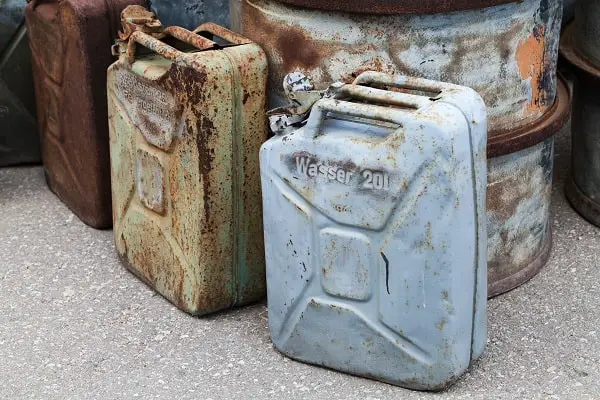
Avoid storing your gas in glass containers, milk jugs, and other insecure containers. These may degrade the gas or even lead to spills. To preserve the longevity of gas and safety, make sure you store it in approved containers only. Also, note that the gasoline cans have a color code:
- Yellow-diesel
- Red-gasoline
- Green-oil
- Blue-kerosene
This information is crucial as when you ask your friend to bring some gas over, and they come with a blue can; you will want to verify what is inside the can before filling up your tank.
Store Gas in a Garage or Shed Outside
Supposing you have filled up your gas can for an off-road trip tomorrow, store the gas can in a detached shed or garage. The garage should not be in contact with the house as it can easily start up a fire and light up the entire building. Some people, however, store the gas in their garages even though they are attached to the main house. It may still be safe, but there are some precautions to take.
Store Gas Cans In a Cool Area
Gas cans should be stored out of reach of children and in a well-ventilated room. Whether the gas can is in an attached or detached shed, ensure that room is ventilated. It should also be relatively cool and 50 feet away from any potential ignition source. Doing these things will significantly reduce the chances of a raging fire.
What Are the Best Gas Cans for Overlanding?
The best fuel cans for overlanding are the Midwest 5-Gallon Metal “Jerry” Gas Can, the Wavian NATO Fuel Can, and the Rugged Ridge 20L Jerry Can.
Read about each of them and choose the one that is right for you.
Midwest 5 Gallon Metal “Jerry” Gas Can
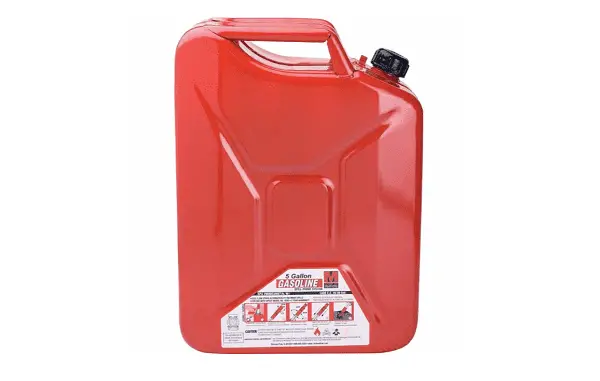
Midwest Can firm has been manufacturing gas storage cans for more than 70 years. You already know they are authentic and produce only high-quality products with such information in mind. This gas can is robust; it can last for a long time. The Midwest 5 Gallon Metal Jerry Gas Can is able to handle the Alaska cold and Nevada heat easily.
It comes with a comfortable handle and bears a stunning auto-grade gloss paint. It also has a pouring spout with an air bleed tube to insure smooth pouring. It also has a protective cap that ensures the gas is safe and secure in the can.
Wavian Jerry Cans
Wavian USA has supplied the NATO countries with these fuel cans for more than 75 years. The company produces robust gas cans that today’s off-road enthusiasts still use. It comes with cold-rolled steel walls of 0.9mm and a rust-proof lining. The other advantage of this gas is that it comes with an internal breather and a splashproof spout. Off-roaders looking for the ideal gas can to hit the off-road should get this can because of its sturdiness and spout included.
Rugged Ridge 20L Metal Jerry Can
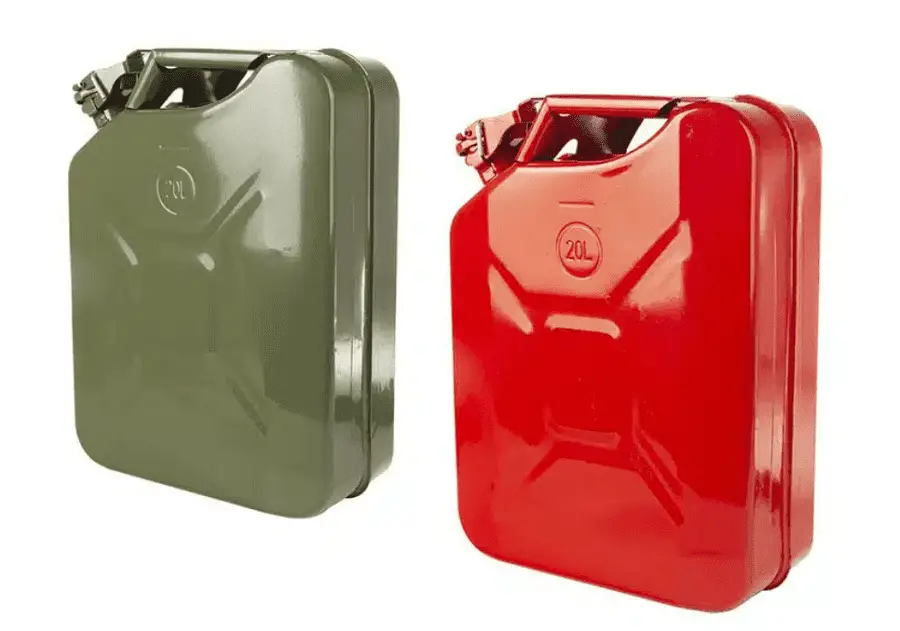
Rugged Ridge has always been a favorite company for most overlanders and off-roaders regarding the gas can. Most off-road enthusiasts love this gas can because of the durability they offer. These cans can last for a long time if you are careful and store them appropriately.
It comes with a 3-bar handle for easy handling when in use and is also created from stamped steel. Rugged ridge cans come with a locking pin and safety hatch to offer the user security. These features will prevent the spillage of the gas.
What Are the Safety Concerns With Storing Gas?
Gas cans can easily be a death trap if you are not careful. If placed near an igniting item, it could light up the entire house with the presence of the tiniest sparkles. Gasoline is very volatile and can explode and bring down a homestead. So how can you avoid such instances of raging infernos?
Use Only Approved Containers
Any gas can designed for gasoline use will have a stamp of approval from the (ASTM) American Society for Testing and Materials or (UL) Underwriters Laboratories. Beware that gasoline can easily melt some materials and plastics. Unapproved materials could lead to vapor leaks which is dangerous. That is why you should only store gasoline in the approved containers.
Do Not Carry Portable Gas Cans in the Passenger Compartment!
It is a great security concern. These fuel cans are made to vent fuel vapor when exposed to high temperatures to have safe internal pressures. That could technically lead to fire hazards or a dangerous accumulation of poisonous fumes in enclosed areas.
Understand that gasoline vapor has carbon monoxide, and this can cause nausea or lightheadedness. When exposed over longer periods, the carbon monoxide could easily kill. Also, have in mind that gas can have the ability to leak these toxic substances even while empty.
Only Fill the Can to 95% Full
As you plan for your next off-road trip and plan to bring with you a gas can, make sure it is only 95% full. Leave some space for the air gap. Fuel is known to increase as the temperatures rise. Leaving an air gap will prevent spillage.
Wipe the Can After Use
Remember to wipe the spilled fuel on the gas can before hitting the road. Since gasoline is highly volatile, even a tiny amount could ignite a fire under the right circumstances. Inhaling this vapor could also be harmful to your health.
Use the Gasoline
Any off-roader or car enthusiast knows that gasoline has a short shelf life. It could last for only three to six months. After this period, the fuel becomes less combustible and reduces octane value. The engine will struggle to run on such fuel and could shut off when idle, and it could also lead to huge expenses on damages.
Final Thoughts
Gasoline is very volatile, which means you should be very careful with it. The cans ought to be secured away from the house if possible and at a far distance from any ignitions.


